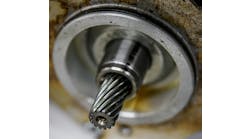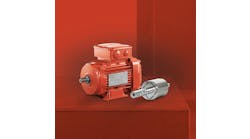When we set out to design a control system, the algorithm that brings all the elements together depends on knowledge of where the various components are at any given moment. The means by which that data is collected and transmitted are what we all know as sensors. Simple motion only requires simple sensors, while complex motion requires something more sophisticated.
One simple motion, where a device meets with a physical barrier like the end of stroke on a cylinder or rotary actuator, the feedback might be translated into the element of time. With a known volume of air (or hydraulic oil) and known pressure of delivery of the medium, a cylinder will travel a known distance in a specific amount of time. The problem with using time is it’s, well, relative. A slight variation in volume or pressure and the device arrives too early or two late. To enhance the indication of simple motion, digital sensors can be used to indicate positions along the path of the motion. Start and end points are the usual points of reference but other sensors can be used along the path to anticipate the arrival at either end of travel or, perhaps, a position in the middle.
Digital feedback is good for relatively slow processes but the desire to move faster renders these simple on or off sensors of limited use. As control processes become more elaborate, other means of feedback must be employed. The more complicated the item being controlled, the more complex the sensing method must be. In a blending operation, for example, opening a rotary valve releases product into a vessel. In order to determine when to close the valve, a means of measurement needs to be employed. A device that measures pressure or flow would be most appropriate for this.
The methods of sensor feedback mentioned thus far work great when the process or motion is relatively slow. Beyond simple motion, however, any control system that involves moving parts must include a more elaborate form of feedback to indicate the physical position of the object in motion rather than the presumed position at a given time.
Motion can be divided into two basic types, linear and rotary. As a matter of fact, in many circumstances a rotary device can be used to induce linear motion through the use of pulleys and belts. The important factor in motion, especially where more than one object is in motion at a time, is to know the precise physical position of each element, relative to the other objects in motion.
Let’s look into the methods of translating linear motion into relational data. The great thing about linear motion is there is a start point and an end point. Since there is a known start point, then any variety of methods can be used to determine the distance between the stationary start point and a point along that linear path. Linear position sensors convert displacement of an object into an output signal.
One simple example of a linear sensor employs a string pot attached between the base of the device and the end of the linear rod. As the device extends, the string extends with it causing a change in the string pot. Another example of this type of technology would be a linear potentiometer. In this situation, the mechanical linear movements are transformed into corresponding electrical variations. Another type of linear sensor measures the distance between a position magnet and head end of a sensing rod. This technology is known as a magnetostrictive linear sensor. In all of these examples, the output can be in the form of analog signals in either voltage or current.
When measuring rotary motion, a different type of sensor is employed. Rotation is measured as equal segments of a circle. A complete circle (one rotation) can be measured in term of degrees, radians, gradians or other equal divisions. The most common measure of a circle learned in school is a degree. There are 360° in a circle. A radian, used in trigonometry is defined as the measure along the circumference of a circle that is equal to the radius of that circle. For that reason, 1 degree equals 57.295°. As one can imagine, when wanting to accurately measure the rotary motion, the use of radians would not make sense. A gradian, on the other hand, is defined as 1/100th of a right angle. A right angle is defined as 90° so 1 gradian is 0.9°. From these examples we can see that measuring in degrees or gradians would provide many more counts for one complete rotation of a shaft.
Early measuring devices would use degrees or radians to convert circular motion into counts relative to the amount of rotation of the driven device. One such early method was to use a disk mounted to a shaft where bumps on the disk would activate a line of switches resulting in a count using binary. Binary, you will remember is a sequence of 1s and 0s (on and off) to represent a count. In such a manner, the turning off or on of switches as the device rotates through 360° would provide a count representing the position of the rotating shaft at any point in the motion. One main disadvantage of this type of technology came with the realization that, at any given time, more than one switch might be changing states at the same time. During these moments, the count would suddenly be unstable. A quick example of this would be a count of 3 (decimal) which is represented at 0111 in binary. To go from 3 to 4, the binary counters (switches) would go from 0111 to 1000. During the exact moment of transition from 3 to 4, the three lower bits would be turning off while the 4 bit would be turning on. The result would be a brief moment where a 0 result would appear between 3 and 4. More likely, since these were mechanica switches being activated but a bump or groove in a disk, other counts as little as 0 and as much as 1111 or 16 decimal could be translated. To solve this issue, a researcher at Bell Labs, Frank Gray, devised a modified binary code, called reflective binary code, where the bumps or gaps in the disk (and associated switch) were rearranged so that only one switch at a time is ever changing state. This development became known as Gray Code and provided a way of accurately representing rotary motion.
Much has changed over the years but these basic principles are very much in play today. The angular relationship between two pulses makes up the encoder that we know today. As technology has improved, the ability to resolve a circle into more and more segments is possible. Where 360 equal segments (counts) might have been possible in the past, multiples of 360° became the norm. 360 pulses per revolution, 720 pulses per revolution 1,640 pulses per revolution … you can see where this goes.
Encoders are divided into two types, incremental and absolute. Incremental encoders begin counting from zero each time they are powered up while absolute encoders retain their count while powered down. For this reason, an incremental encoder must always come back to a reference position when first powered up to provide an accurate representation of rotation made after the “homing” move. Generally, incremental encoders tend to count in pulses per revolution and absolute encoders count in bits. Some high resolution absolute encoders can count over 10,000 bits per revolution.
In recent years, encoder technology has been enhanced by the emergence of communications protocols that have become commonplace in controls designs. Early encoders depended on specialty modules to convert the electrical counts (like Gray Code) into position feedback. Now, with an easy-to-use connection to network protocols like Profibus or Ethernet I/P, encoders are a snap to install and commission. Modern day marvels include numerous value added features like software configuration to change parameters like resolution and direction simply by changing a value in the programming interface. My favorite automation company has added some more features like teachable home positions (resetting the count or setting it to a specific value) and velocity feedback in addition to the traditional position feedback value. With the ever present Internet of Things, the encoder of today can even provide health status of the device.
It’s hard to imagine that just a few years ago (or so it seems) the inclusion of an encoder meant adding code to convert a Gray Code device back into a decimal representation of a rotary position. With motion so easy to implement and feedback so accurate, it’s not hard to imagine a future where all devices will be electro-motion activated. What’s your position?






